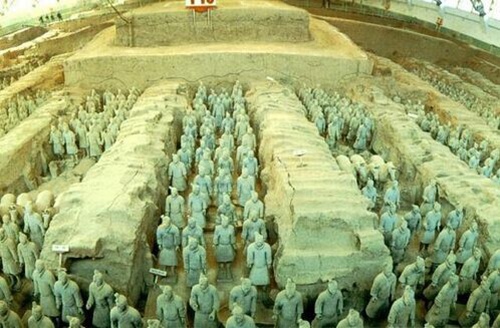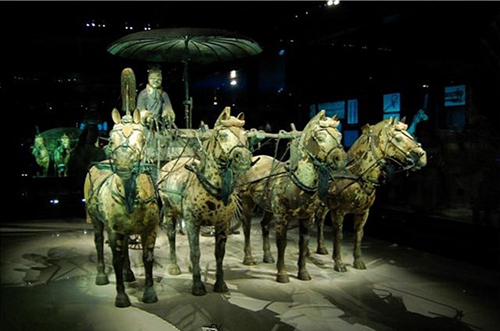 |
|
Terracotta Warriors in the tomb of Emperor Qin Shihuang are among the most impressive items in the mausoleum. [Photo/chinaculture.org] |
The mausoleum has since been discovered and was designated as a World Heritage Site by UNESCO in December 1987. Better known as the site of the Terracotta Warriors, it is the largest underground tomb in the world and remained undiscovered for more than 2,000 years.
Archeologists began work on the tomb in the early 1960s after a group of construction workers happened upon the site. In the subsequent decades, discovery after discovery unfurled, and excavation of new burial pits surrounding the center of the mausoleum continue to this day. The mausoleum covers 56.25 square km - 78 times the area of Beijing’s grandiose Forbidden City.
Emperor Qin Shihuang was a deeply superstitious man. It was his belief that whatever he left this world with would pass with him to immortality in the afterlife that ultimately led to the construction of the massive tomb. The mausoleum, a subterranean world that mirrored his power and influence in real life, is the most spectacular of its kind in the world.
The site was considered an ideal place for the emperor's tomb because of its location. High above sea level, with mountains behind and a river in front, the geography of the site fits well with the concepts of feng shui (pronounced phonetically as fung shuay), the traditional Chinese system of choosing sites and positions in harmony and balance.
Ancient documents detailing the construction and layout of the tomb describe its depth at the time and the use a vermilion stone wall to block groundwater and seal its contents. Inside the tomb were palaces and burial chambers of Emperor Qin and his high officials. Treasures and jewels were stored and whale-oil candles burned 24 hours a day. Booby traps, such as hidden arrows, protected the tomb from robbers and looters.
The rectangular-shaped burial chamber of the emperor, situated in the middle of the palace, is about 15m deep, 100-110 meters long and 64-75m wide - about the same size as a soccer field.
Over 100 satellite burial pits and tombs, both large and small, have so far been unearthed. The largest and most attractive is undoubtedly the one housing the Qin terracotta army. About 8,000 life-size terracotta warriors and horses, covering an area of over 20,000 sq m, were built to protect the emperor in the afterlife.
Another well-known pit is one containing two painted bronze chariots. The half life-size burial articles are believed to be deluxe sedans for the emperor to conduct inspection tours in the afterlife. They were originally painted in exquisite colors and appeared much more magnificent than they look today.
 |
| Bronze chariots and horses.[Photo by Liu Jiaxin] |
A newly-discovered pit containing pottery acrobats and a bronze tripod tells us there was more to the emperor's life than political affairs. Clad in short skirts, the life-size figures vary in postures as if they were performing on stage; they are more active and expressive than the terracotta warriors.
The mausoleum seems to depict the whole of China in miniature and has acted as a valuable snapshot in history for modern day anthropologists and historians. For anyone who wants to know more about China's past, this splendid necropolis is definitely not to be missed.
Edited by Jacob Hooson
